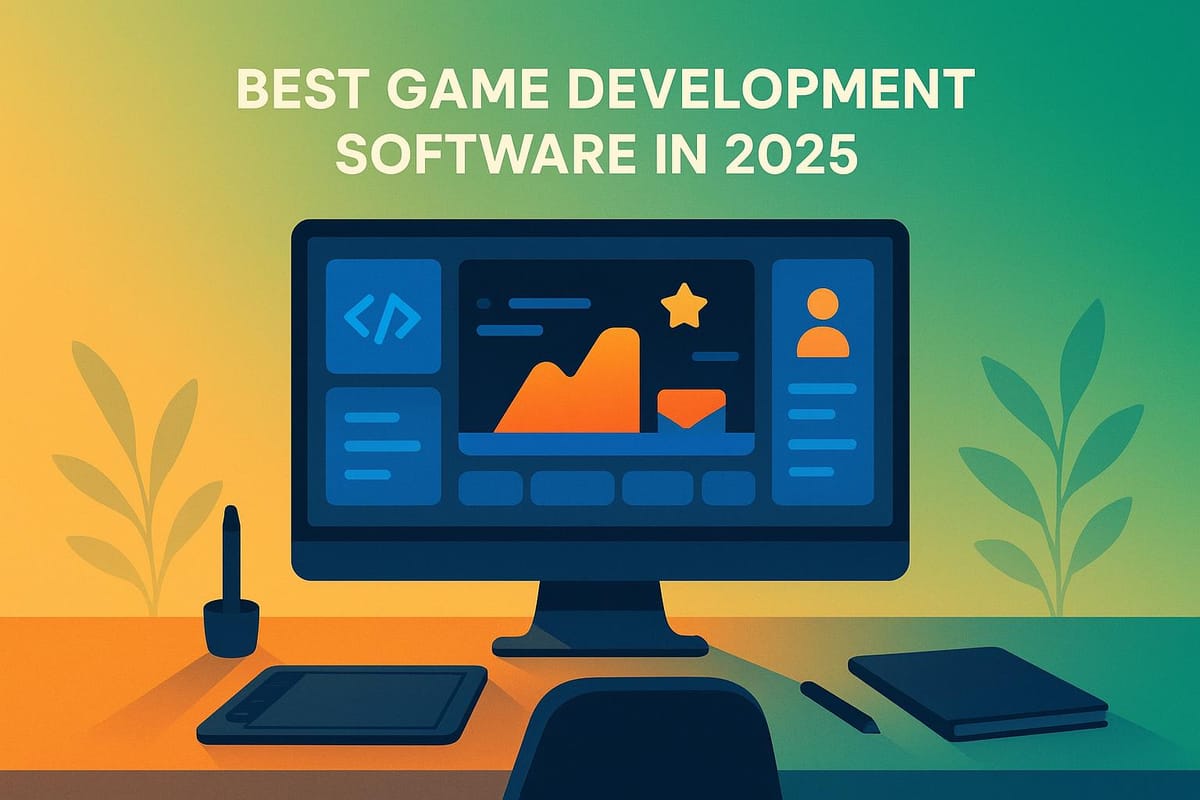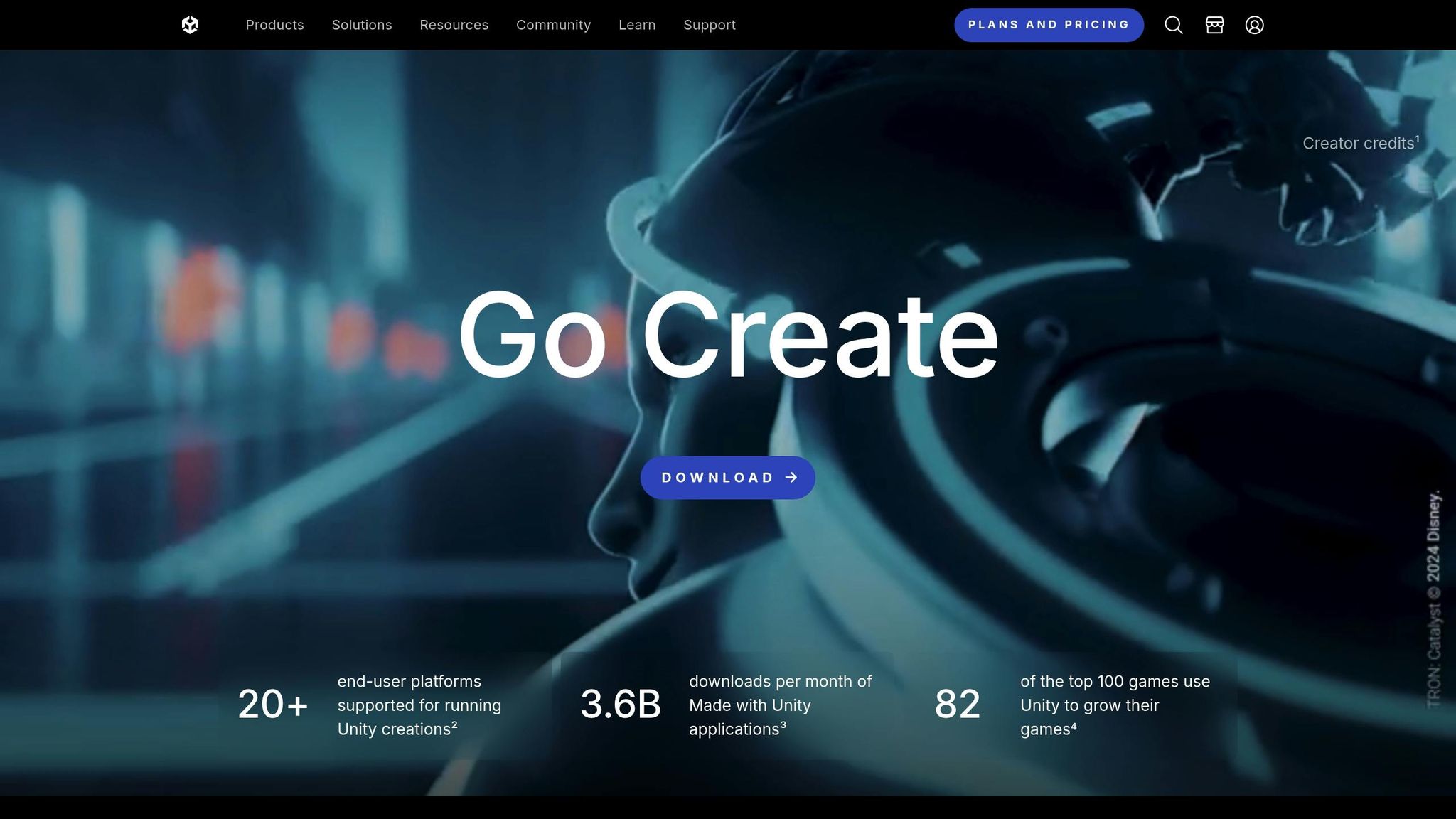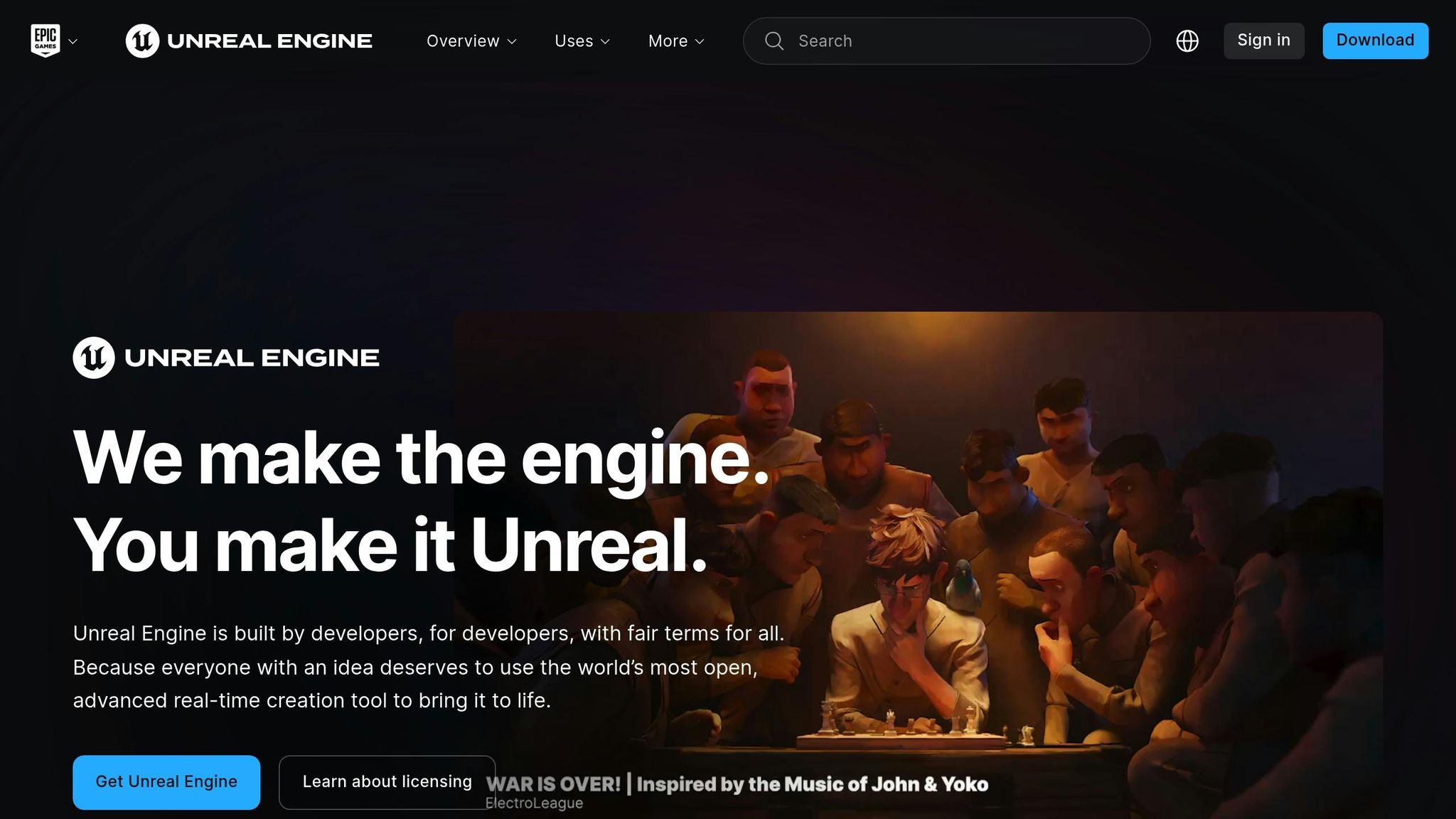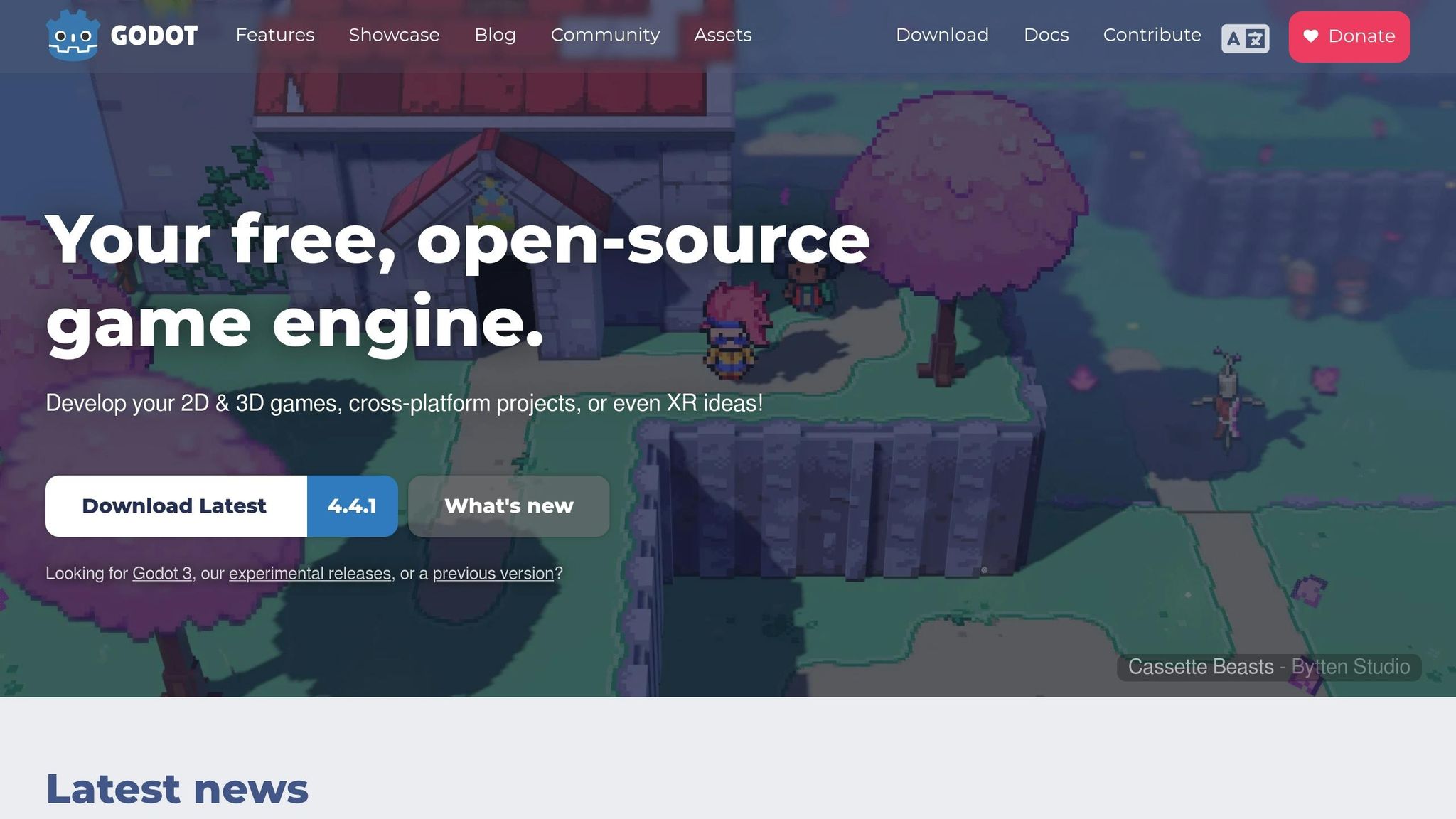Best Game Development Software in 2025
Explore the top game development software options in 2025, including features, pricing, and suitability for different skill levels and project types.

Looking to create your next game in 2025? Here's the breakdown: Unity, Unreal Engine, and Godot dominate the scene. Each offers tools tailored to different needs - whether you're a beginner, an indie developer, or a professional studio.
- Unity: Ideal for mobile and VR/AR projects, with a user-friendly interface and wide platform support. Its new AI tools and enhanced rendering make it a solid choice for diverse projects. Pricing starts free for small developers, with Pro at $2,200/year.
- Unreal Engine: Known for stunning visuals and advanced tools, Unreal excels in AAA and large-scale projects. Free to use until $1M revenue, then a 5% royalty applies.
- Godot: A free, open-source option perfect for indie developers and 2D projects. While its 3D tools are improving, it remains lightweight and easy to learn.
Quick Comparison
| Engine | Best For | Cost | Key Features | Limitations |
|---|---|---|---|---|
| Unity | Mobile, VR/AR, all levels | Free for <$200K, $2,200/year Pro | AI tools, cross-platform support | Graphics may lag for AAA games |
| Unreal Engine | AAA, high-end visuals | Free <$1M, 5% royalty >$1M revenue | Cutting-edge graphics, Blueprints | Steeper learning curve, high specs |
| Godot | Indie, 2D projects | Free | Open-source, lightweight | Limited 3D features |
Choosing the right engine depends on your goals, budget, and expertise. Dive into the details below to find your perfect match.
choosing a game engine is easy, actually
1. Unity

Unity continues to lead the game development world, powering 71% of the top 1,000 mobile games and reaching over 2 billion users globally. With a 48% market share, Unity remains a top choice for developers, offering improved stability, performance, and cutting-edge AI tools in 2025.
Features and Capabilities
The release of Unity 6.1 in 2025 marks a major step forward, building on Unity 6.0 with enhanced performance and a Production Verification approach. This ensures every feature is thoroughly tested in real-world scenarios, giving developers confidence in the engine's reliability.
Unity's cross-platform development tools allow creators to deploy games to over 20 platforms, including desktop, mobile, consoles, web, and XR devices, all from a single codebase.
This year, Unity's graphics systems have seen significant upgrades. The Deferred+ rendering path in the Universal Render Pipeline (URP) allows for the creation of more detailed environments, while Variable Rate Shading boosts GPU performance without sacrificing visual quality. For high-end projects, the High Definition Render Pipeline (HDRP) delivers visuals that rival AAA productions.
Unity is also integrating AI-powered workflows, a game-changer for 2025. Tools like Unity Muse and Unity Sentis simplify asset creation and embed machine learning directly into projects. This shift aligns with the fact that 96% of studios now use AI tools in some capacity.
The engine's DOTS (Data-Oriented Technology Stack) and ECS (Entity Component System) architecture enable developers to write high-performance code by separating data from logic. Combined with NVIDIA's PhysX engine and the Mecanim animation system, Unity provides the tools needed to craft complex game mechanics.
Unity's thriving Asset Store offers thousands of pre-made assets, cutting down development time and costs. Meanwhile, the Project Center helps developers explore new features through guided experiments with both Unity's tools and third-party integrations.
These technical advancements are complemented by a developer-friendly pricing model.
Pricing and Cost-Effectiveness
In January 2025, Unity made waves by eliminating the controversial Runtime Fee. The new revenue-based pricing structure ensures accessibility for developers at all levels.
- Unity Personal: Free for developers with revenue and funding under $200,000, making it ideal for students, hobbyists, and small indie teams.
- Unity Pro: Priced at $2,200 per seat annually, this tier is required for developers earning over $200,000 in revenue or funding. Despite an 8% price increase, it includes advanced features for professional-grade projects.
- Unity Enterprise: Designed for companies generating over $25 million annually, this tier offers custom pricing and enterprise-level support, though it saw a 25% price increase.
Unity CEO Matt Bromberg addressed these changes directly:
"Canceling the Runtime Fee for games and instituting these pricing changes will allow us to continue investing to improve game development for everyone while also being better partners."
The platform is widely praised for its value, earning a 4.5/5 rating for Value For Money on Capterra. Many users describe it as "the best and most cost-effective method of creating and publishing games".
Suitability for User Levels
Unity's flexibility makes it a solid choice for developers at any skill level. With 60% of game developers worldwide using Unity, its user-friendly interface and extensive tutorials are perfect for beginners. Features like visual scripting and a wealth of learning resources allow newcomers to focus on creativity rather than technical hurdles.
Indie developers benefit from Unity's affordability and versatility. The free Personal tier lets small teams create and publish games with minimal upfront costs, while the Asset Store provides budget-friendly solutions for common development needs. Unity's cross-platform capabilities also allow indie projects to reach wider audiences without additional development effort.
For professional studios, Unity's advanced tools and scalability shine. Its support for 3D graphics, VR/AR development, and multiplayer networking, combined with a Long Term Support (LTS) model that includes two years of support for Unity 6.0 (plus an extra year for Enterprise users), ensures the stability required for large-scale projects.
In line with current trends, 64% of developers are working on multiplayer games, and 90% are launching on mobile platforms. Unity's robust multiplayer features and mobile optimization tools make it a smart choice for developers aiming to stay ahead in the gaming industry.
2. Unreal Engine

Unreal Engine is the driving force behind visually stunning AAA games. Its latest iteration, Unreal Engine 5.6, equips developers with tools to create expansive open worlds that perform seamlessly at 60 FPS on modern hardware.
The engine’s community is thriving, with users logging over 11.2 billion hours across 260,000 live creator-made islands in UEFN. Epic Games has paid out $722 million to third-party creators, while its store has distributed more than $2.1 billion to partners. Unreal Engine’s cutting-edge features continue to reshape the game development landscape.
Features and Capabilities
Unreal Engine 5.6 introduces a range of powerful tools designed to enhance every stage of game development.
- Nanite allows developers to handle intricate geometry without sacrificing performance.
- Lumen offers dynamic global illumination, adapting to lighting changes in real time.
For character creation, the MetaHuman Creator enables the production of lifelike digital humans, shifting workflows toward an "engine-first" animation pipeline. This reduces reliance on external software and simplifies production.
The Blueprint visual scripting system empowers developers to build game logic without requiring extensive coding knowledge. Meanwhile, Chaos Physics replaces PhysX, delivering advanced real-time simulations, from cloth dynamics to destructible environments. Paired with World Partition, developers can now manage large-scale open-world games with greater ease.
Audio design also gets an upgrade with MetaSounds, a node-based system that mirrors the Material Editor used for graphics. To streamline development further, the Unreal Engine Marketplace offers a vast library of plugins and assets.
Pricing and Cost-Effectiveness
Unreal Engine’s pricing model is designed to be accessible to developers at all stages. Here’s how it breaks down:
- Free for students, educators, and hobbyists, as well as companies earning less than $1 million in annual revenue.
- For game developers surpassing this threshold, a 5% royalty applies to lifetime gross revenue exceeding $1 million.
- Revenue earned through the Epic Games Store is exempt from royalty fees.
For non-game developers generating over $1 million annually, an Unreal Subscription costs $1,850 per seat per year, which includes access to Unreal Engine, Twinmotion, and RealityCapture. Additionally, the "Launch Everywhere with Epic" program lowers the royalty rate to 3.5% for games launched on the Epic Games Store either concurrently with or before other platforms.
| User Type | Pricing Model | Annual Cost | Revenue Threshold |
|---|---|---|---|
| Students, Educators, Hobbyists | Free | $0 | Under $1M annual revenue |
| Game Developers | 5% royalty | Variable | Over $1M lifetime revenue |
| Non-Game Developers | Per-seat subscription | $1,850 | Over $1M annual revenue |
This pricing structure allows independent developers to access professional-grade tools without upfront costs, giving them the freedom to experiment and refine their projects. However, some developers feel that the 5% royalty can be burdensome for highly successful games, and additional costs for third-party plugins may add up.
Suitability for User Levels
Unreal Engine’s extensive features and fair pricing make it a versatile tool for developers of all experience levels. While it does have a steeper learning curve compared to some alternatives, its visual scripting system (Blueprint) makes it more accessible than many expect. Beginners benefit from comprehensive documentation and a supportive community, while experienced developers can push the boundaries of visual fidelity.
Indie developers value the free tier and built-in tools that allow smaller teams to achieve AAA-quality visuals. The Blueprint system facilitates rapid prototyping and encourages collaboration between technical and non-technical team members.
For professional studios, Unreal Engine shines in high-end productions. Its support for high-refresh-rate displays (up to 120Hz) and advanced optimization tools helps studios deliver polished experiences to wide audiences. Additionally, Unreal’s reputation in the AAA space enhances credibility when pitching projects to publishers or investors.
3. Godot

Godot is an open-source game engine licensed under the MIT license, making it a popular choice among indie developers. Its appeal lies in being completely free to use and offering a modifiable source code. With a node-based architecture that organizes game elements into scenes, Godot simplifies the process of managing complex setups.
Features and Capabilities
Godot brings a host of practical tools to the table, catering to various development needs while embracing the benefits of being open-source.
The engine's lightweight design ensures efficient cross-platform rendering and visual effects. Developers can deploy their games on platforms like Windows, Linux, macOS, HTML5, Android, iOS, and others with ease.
For scripting, Godot uses GDScript, a language with Python-like syntax that's beginner-friendly yet powerful enough for advanced projects. Developers who prefer other languages aren't left out, as the engine also supports C++ and C#, providing flexibility for diverse coding preferences.
When it comes to 2D game development, Godot excels. It boasts efficient resource management and an optimized renderer, ensuring smooth performance even on less powerful machines. As one reviewer shared:
"Godot is a user-friendly game engine that is suitable for beginners. Game development is made simpler and quicker by its node-based architecture and support for sprite sheets. It is lightweight; it may function well on PCs with lower specifications."
– Pat E., Godot Review
For developers working on 3D projects, Godot includes a native physics engine and, starting with version 4.x, supports third-party physics integration via GDExtension. However, its 3D tools, while functional, may fall short compared to more established engines in areas like virtual reality and complex physics simulations.
Pricing and Cost-Effectiveness
Godot’s pricing model is refreshingly straightforward: it’s completely free. There are no hidden fees, royalties, or subscriptions. Under the MIT license, developers can use, modify, and distribute the engine commercially without restrictions. This ensures that whether you're a hobbyist or running a professional studio, you retain full ownership of your creations.
| Cost Component | Godot | Industry Standard |
|---|---|---|
| Engine License | Free | $0 – $1,850/year |
| Revenue Royalties | 0% | 3.5% – 5% |
| Commercial Use | Unlimited | Often restricted |
This zero-cost model is especially appealing in a market where game engines often come with financial strings attached. With the global game engine market valued at $2.42 billion in 2023 and projected to grow by over 12.3% annually through 2032, free options like Godot are becoming increasingly attractive.
Suitability for User Levels
Godot’s features make it a versatile choice for users of all experience levels.
For beginners, the engine offers an intuitive editor, a streamlined scene system, and GDScript, which simplifies the learning curve. Its lightweight design allows newcomers to experiment freely without dealing with complex setups.
Indie developers benefit from Godot's open-source nature and active community support, which fosters collaboration and provides resources to ease the transition from other game engines.
Professional studios, particularly those focusing on 2D games or smaller 3D projects, can take advantage of Godot’s efficiency and customization options. However, for teams requiring cutting-edge 3D graphics or virtual reality capabilities, Godot's 3D tools might feel limiting.
As one industry observer aptly described:
"Godot's the rising indie band everyone swears they discovered first, offering a free, open-source alternative to corporate game engines."
– Ameera Rahaman, Content Manager
Pros and Cons
Choosing the right game engine depends on your project's specific needs, as each platform comes with its own strengths and weaknesses. Here's a breakdown of the key advantages and challenges for three popular engines:
| Engine | Pros | Cons |
|---|---|---|
| Unity | • Works seamlessly across platforms • Large community and detailed documentation • Extensive asset store for faster development • Easy-to-learn C# scripting • Strong support for mobile and VR projects |
• Graphics may fall short for high-end visuals • Performance issues on complex projects • Subscription fees for professional features |
| Unreal Engine | • Top-tier graphics and rendering capabilities • Comprehensive tools for AAA games • Scales well for large projects • Visual scripting with Blueprints makes some tasks easier • Free to use until revenue hits $1 million |
• High system requirements can strain resources • Steep learning curve, especially with C++ • Advanced hardware needs can increase costs |
| Godot | • Free and open-source with no licensing fees • Lightweight and efficient for smaller projects • Beginner-friendly interface • Ideal for 2D game development • GDScript offers Python-like simplicity |
• Limited 3D capabilities compared to Unity and Unreal • Smaller community means fewer tutorials and resources • Fewer plugins and assets available • Less suited for large-scale, complex games |
These comparisons highlight how each engine fits different scenarios based on performance, scalability, ease of learning, and cost.
- Performance and Scalability: Godot shines in 2D game development with its lightweight design, making it a great choice for smaller projects. Unity strikes a balance with strong mobile and VR performance, while Unreal dominates in delivering cutting-edge visuals but demands more powerful hardware.
- Learning Curve: Unity offers a more approachable experience, especially for beginners, thanks to its user-friendly interface and C# scripting. Unreal, while incredibly powerful, requires advanced skills, particularly in C++ programming. Godot’s simplicity makes it beginner-friendly, especially for those familiar with Python-like languages.
- Cost: Godot stands out as completely free and open-source, eliminating any licensing fees. Unity offers a mix of free and subscription-based options, with additional costs for assets. Unreal’s model is free until your project earns $1 million, after which a 5% royalty applies.
Ultimately, the best engine for your project depends on your goals, budget, and technical expertise. Carefully weigh these factors to choose the platform that aligns with your vision.
Conclusion
Choosing the right game development software in 2025 ultimately depends on your specific goals and the strengths each platform brings to the table.
Unity stands out as a great option for beginners and hobbyists. With over 70% of mobile games created using Unity, it’s an industry staple that offers tools widely recognized by professionals. Learning Unity not only helps you build games but also equips you with a valuable skill set.
While Unity is a versatile choice, indie developers may find Godot appealing. This open-source platform is completely free, eliminating licensing concerns. Its lightweight design makes it particularly strong for 2D game development, and its 3D capabilities are steadily advancing.
For professional studios and experienced designers, Unreal Engine is the go-to platform for high-end projects. Known for its advanced graphics and cutting-edge tools, Unreal delivers stunning visuals and offers the Blueprint visual scripting system, making it easier to create complex games. Its pricing model remains developer-friendly, only charging fees after hitting specific revenue thresholds.
Meanwhile, no-code tools and advancements in VR/AR technology are making game creation more accessible than ever . Whether you're crafting your first game or aiming for a blockbuster, these platforms offer a strong foundation to bring your vision to life.
For those looking to deepen their skills, Upskillist offers expert-led courses tailored to game development. Start your 7-day free trial today and explore personalized learning paths to help you master these powerful tools.
FAQs
What are the key differences between Unity, Unreal Engine, and Godot, and which types of developers and projects are they best suited for?
In 2025, Unity remains a strong pick for beginners and indie developers. Its user-friendly interface, vast community support, and extensive asset store make it perfect for mobile games, 2D projects, and small to mid-sized games.
If you're aiming for high-end 3D projects or AAA games, Unreal Engine is the go-to choice. It delivers top-tier graphics, exceptional performance, and tools tailored to create visually impressive, large-scale experiences.
For those focusing on simpler 2D games or lightweight indie projects, Godot offers a practical solution. It’s easy to learn, has a gentler learning curve, and provides an efficient engine for developers prioritizing simplicity and ease.
How do game engine pricing models impact indie developers compared to large studios?
Game engine pricing models tend to affect indie developers more than larger studios. Many popular engines, such as Unity and Unreal Engine, provide free or affordable plans that give smaller teams or solo creators access to powerful tools. These entry-level options usually come with limits based on revenue or downloads, making them a great fit for indie developers who are just starting out.
For bigger studios, however, costs can escalate quickly once they surpass those revenue or download caps. Licensing fees or per-download charges can stack up, sometimes reaching thousands of dollars each month. While this approach lowers the financial barrier for smaller creators, it ensures that larger studios pay more as their projects achieve greater success. This system helps keep advanced tools accessible to everyone, from hobbyists to seasoned professionals.
What are the key advancements in game development technology, like AI tools and VR/AR features, for Unity, Unreal Engine, and Godot in 2025?
In 2025, Unity, Unreal Engine, and Godot are at the forefront of game development, pushing boundaries with advancements that are reshaping the industry. These platforms are integrating AI-powered tools to tackle time-consuming tasks like asset creation, procedural scene generation, and character animation. The result? A faster, more accessible game development process that welcomes creators of all experience levels.
When it comes to VR/AR development, these engines are stepping up their game with streamlined workflows, support for higher-resolution displays, and improved field-of-view (FOV) capabilities. These updates aim to deliver immersive, lifelike experiences, meeting the needs of both indie developers and major studios. It's a win-win for flexibility and creativity.

